Are you wondering about best time to visit Sri Lanka ? Sri Lanka, a gem in the Indian Ocean, is renowned for its diverse landscapes, rich history, and vibrant culture. This island nation is a year-round destination, offering something unique in every season. Its proximity to the equator ensures stable, warm temperatures throughout the year, making it an ideal getaway for travelers seeking a blend of adventure, relaxation, and cultural immersion.
However, Sri Lanka’s weather is significantly influenced by its dual monsoons. The Yala monsoon affects the south and west coasts from May to August, while the Maha monsoon impacts the north and east from October to January. Understanding these monsoon patterns is crucial for planning your visit, as they can affect everything from wildlife sightings to beach conditions.
Table of Contents
Sri Lanka’s Climate
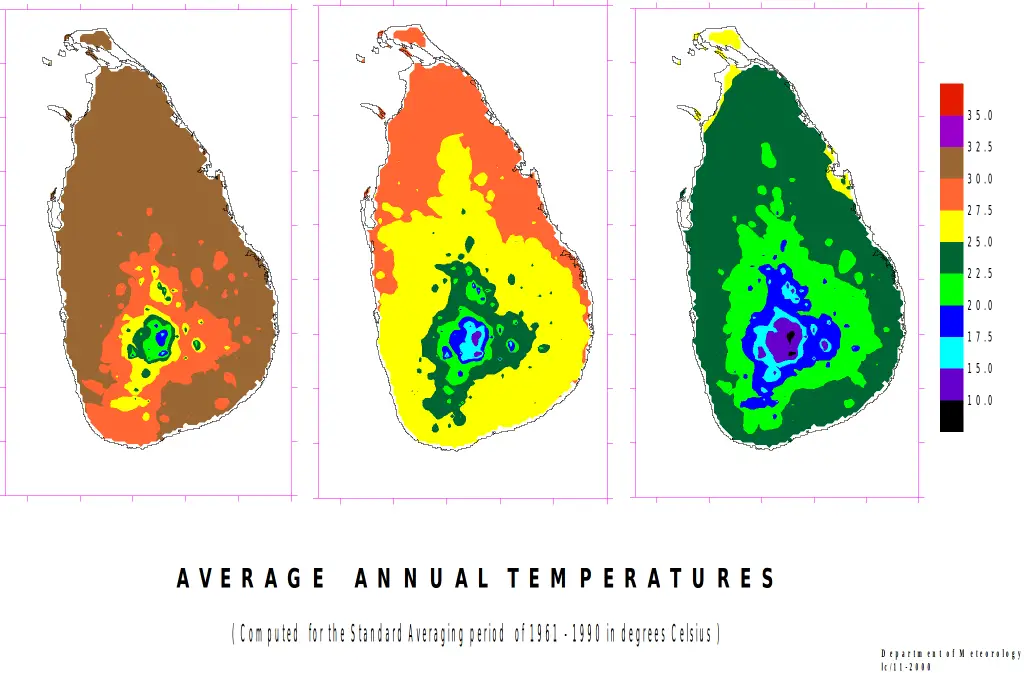
Sri Lanka’s climate is predominantly tropical, characterized by high humidity and warm temperatures throughout the year. This climatic condition makes it an ideal destination for those seeking sun, sand, and sea. However, the island is also subject to two main monsoon seasons – the Yala and Maha monsoons – which significantly influence the best time to visit Sri Lanka.
- Yala Monsoon (May to September): Affects the southwest part of the island, bringing heavy rainfall and making it less ideal for beach activities in these regions.
- Maha Monsoon (November to February): Impacts the northeast, bringing milder rainfall but generally pleasant weather conditions, suitable for exploring the cultural sites and northern beaches.
Knowing these weather patterns is crucial for travelers to make informed decisions about when and where to visit in Sri Lanka. The inter-monsoon periods – March to April and September to October – often bring sporadic rain but can also offer sunny days, making them a potential option for those willing to take a chance for fewer crowds.
The tropical climate and temperature range in Sri Lanka provide a comfortable environment for tourists year-round. The island’s proximity to the equator ensures that temperatures rarely drop below 78°F, even during the cooler months. However, the humidity level can be quite high, especially in coastal areas. This warm weather makes Sri Lanka a perfect destination for those seeking a tropical escape, regardless of the season.
When planning a trip to Sri Lanka, understanding the differences between peak and off-peak tourist seasons is crucial, as each has its own set of advantages and disadvantages.
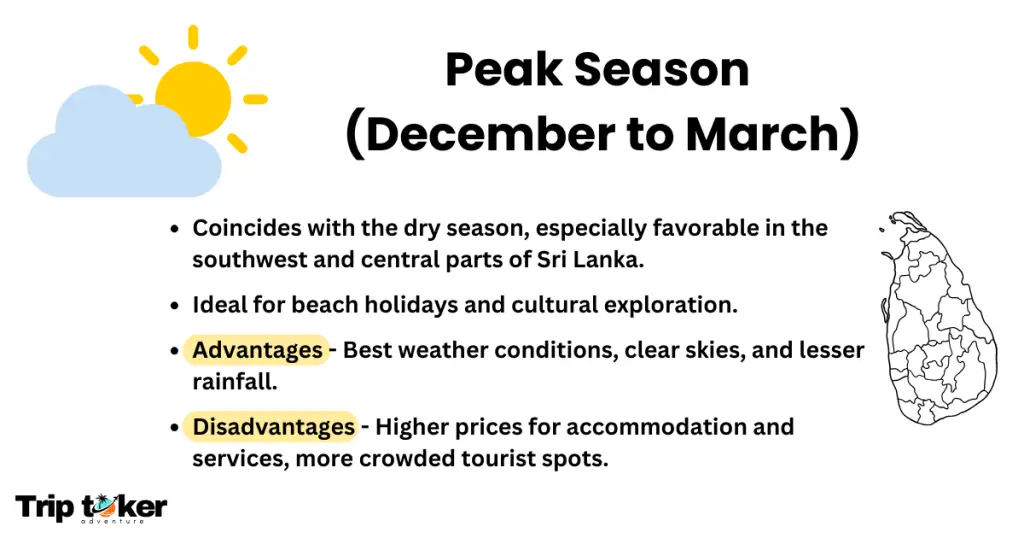
- Peak Season (December to March):
- Coincides with the dry season, especially favorable in the southwest and central parts of Sri Lanka.
- Ideal for beach holidays and cultural exploration.
- Advantages: Best weather conditions, clear skies, and lesser rainfall.
- Disadvantages: Higher prices for accommodation and services, more crowded tourist spots.
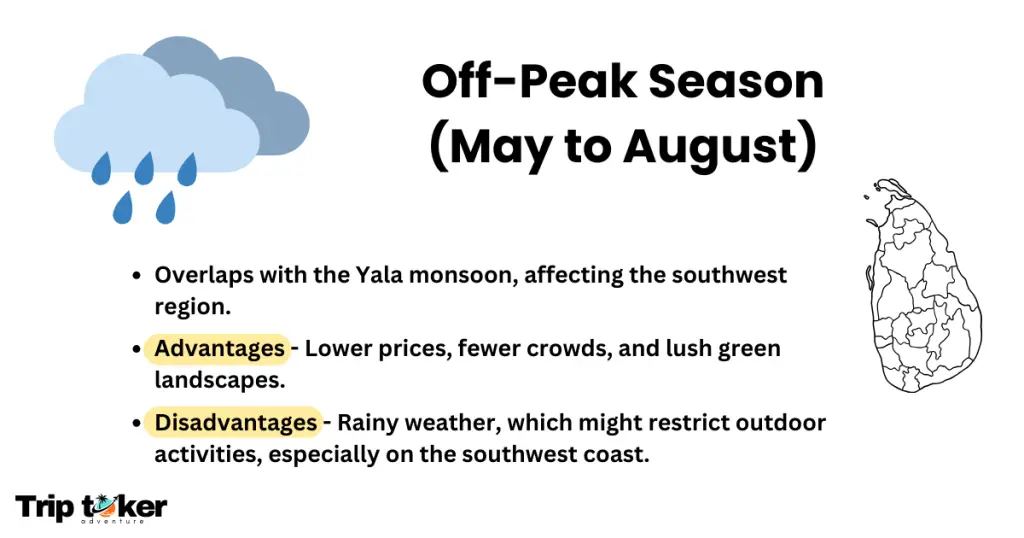
- Off-Peak Season (May to August):
- Overlaps with the Yala monsoon, affecting the southwest region.
- Advantages: Lower prices, fewer crowds, and lush green landscapes.
- Disadvantages: Rainy weather, which might restrict outdoor activities, especially on the southwest coast.
Best Time To Visit Sri Lanka for Beach Holidays
December to March
The period from December to March is considered the high season for beach holidays in Sri Lanka, especially on the south and west coasts which is one of the best time to visit Sri Lanka. This is when the weather is most favorable for beach activities, with clear skies and calm seas. During this time, popular coastal resorts like Hikkaduwa and Mirissa come alive, offering tourists a perfect blend of sun, sand, and sea.
- Unawatuna: Renowned for its stunning beach and historical significance, Unawatuna offers a blend of natural beauty and cultural richness. The area is known for its soft sand, clear waters, and the nearby Galle Fort, making it an ideal spot for both relaxation and exploration.
- Hikkaduwa: Known for its vibrant coral reefs and surf breaks, Hikkaduwa is a haven for snorkelers, divers, and surfers. The clear waters and rich marine life make it a must-visit destination for everyone
- Mirissa: This quaint beach town is famous for its picturesque coastline and is a popular spot for whale watching. The calm and serene beaches of Mirissa provide a perfect escape for those looking to relax and unwind.
Suggestions | Read Now : 7 Places to Visit In Sri Lanka 2024 : 2 Weeks Tour Guide
While the south and west coasts bask in sunshine, the Maha monsoon brings rain to the north and east of the island. This contrast highlights the unique aspect of Sri Lanka’s climate, where one part of the island enjoys dry, sunny weather while another experiences the monsoon. This diversity in weather patterns ensures that Sri Lanka offers varied experiences throughout the year, catering to different preferences and interests.
Destinations for tourists between April and September – ” While the southwest experiences the Yala monsoon, the eastern coast, including places like Trincomalee and Arugam Bay, becomes ideal for beach visits. This period offers excellent conditions for surfing and other water activities on the eastern coast. Lesser rainfall and sunny days make it perfect for enjoying the pristine beaches in the east. “
Wildlife Watching: Tourist Season
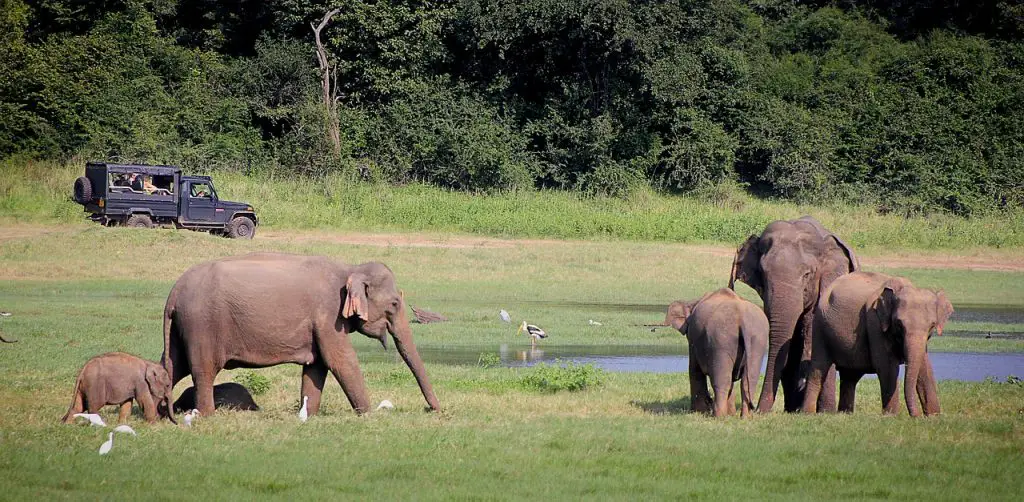
Sri Lanka is not just about picturesque beaches and cultural festivals; it’s also a haven for wildlife enthusiasts. The island’s diverse ecosystems make it an ideal spot for spotting a wide range of wildlife, including elephants, leopards, and buffalo.
- Best Times for Wildlife Spotting: The period from November to April aligns with the tourist season and is considered the best time to visit Sri Lanka for wildlife watching. This is when the dry conditions prevail, especially in the national parks, making it easier to spot animals as they gather around water holes.
- Elephants: These majestic creatures can be seen in several national parks, with Minneriya National Park being famous for ‘The Gathering’ of elephants.
- Leopards and Buffalo: Yala National Park offers some of the best leopard sightings in the world, while buffalo are commonly spotted in many grassland areas.
The dry conditions not only make it easier to navigate the parks but also increase the chances of encountering these magnificent animals in their natural habitat.
Cultural Highlights and Festivals
Sri Lanka’s rich cultural tapestry is vividly displayed in its numerous festivals and celebrations, which are deeply intertwined with the country’s history and traditions.
- Kandy Esala Perahera: The Kandy Esala Perahera is one of Sri Lanka’s most iconic and vibrant festivals, held annually in the historic city of Kandy. This grand event, steeped in rich cultural and religious significance, is celebrated to honor the Sacred Tooth Relic of Lord Buddha, housed in the Temple of the Tooth. The festival occurs in July or August, coinciding with the Buddhist month of Esala which is one of the best time to visit Sri Lanka to experience Cultural Highlights. It features a spectacular procession with ornately decorated elephants, traditional dancers, drummers, and fire performers, creating a mesmerizing spectacle. The Esala Perahera is not just a religious ceremony but a symbol of Sri Lanka’s deep-rooted heritage and a must-see for anyone visiting during this time.
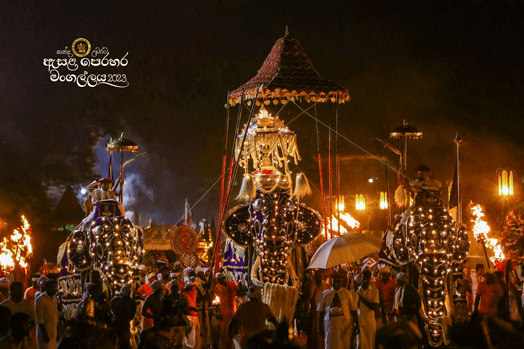
- Sri Pada (Adam’s Peak) Pilgrimage Season: Adam’s Peak, known in Sri Lanka as Sri Pada, is renowned for its summit featuring a sacred footprint, officially recognized as that of Buddha. This significant mountain, rising to 2,243 meters, is a major pilgrimage site, drawing visitors from various backgrounds. From December to mid-April, the pilgrimage season to Adam’s Peak is a significant event. This sacred mountain attracts thousands of pilgrims of various faiths, who undertake the climb to witness the spectacular sunrise and the sacred footprint at the summit.

- Christmas and New Year Celebrations: Despite a small Christian population, Christmas and New Year are celebrated with great enthusiasm across Sri Lanka. The festive season is marked by vibrant decorations, lively events, and a spirit of communal harmony.
- Duruthu Perahera: Held in January in Kelaniya, Colombo, this festival commemorates the Buddha’s first visit to Sri Lanka. It’s a grand event featuring elaborate parades with dancers, drummers, and beautifully decorated elephants.
- Galle Literary Festival: Also in January, the historic city of Galle hosts its renowned literary festival. This event attracts authors, artists, and literary enthusiasts from around the globe, turning the UNESCO World Heritage site into a hub of intellectual and cultural exchange.
These festivals not only offer a glimpse into the rich cultural heritage of Sri Lanka but also provide an opportunity for visitors to engage with the local traditions and community life.
Shoulder Seasons: Exploring the Whole Country
The shoulder seasons of Sri Lanka, spanning from September to October and April, present a unique opportunity to explore the island nation in its entirety. These months are characterized by milder weather conditions, making them ideal for various outdoor activities and exploration.
- September to October: This period is perfect for those looking to experience the diverse landscapes of Sri Lanka without the crowds of peak season which is one of the best time to visit Sri Lanka. The weather is generally pleasant, allowing for comfortable travel across the country.
- Trekking in the Hill Country: The Hill Country, with its lush tea plantations and scenic mountain ranges, offers some of the best trekking experiences. Destinations like Ella and Nuwara Eliya are particularly popular during this time.
- Climbing Sigiriya: The ancient rock fortress of Sigiriya, a UNESCO World Heritage site, is a must-visit. Climbing this iconic rock formation in the cooler weather of the shoulder season is a memorable experience.
- April: This month is marked by a series of traditional activities, cultural events, and public celebrations, offering tourists a unique and enriching experience which is one of the best time to visit Sri Lanka.
Things to Experience in Sri Lanka During April (Click To Expand)
1. Participating in Traditional New Year Rituals: The New Year, usually falling in mid-April, is celebrated with various traditional rituals that are deeply rooted in Sri Lankan culture. Tourists can witness or participate in customs like the lighting of the hearth, preparation of traditional sweetmeats, and the anointing of oil, which are carried out at auspicious times.
2. Enjoying Local Games and Sports: The New Year celebrations include a variety of traditional games and sports, such as pillow fighting (Kotta Pora), climbing the greasy pole (Lissana Gaha), and tug-of-war. These games are not only fun to watch but also open for tourist participation, offering a chance to interact with locals and experience the community spirit.
3. Savoring Traditional Sri Lankan Cuisine: The New Year is a time when special dishes are prepared. Tourists can indulge in traditional sweets like Kavum (small oil cakes), Kokis (crispy, sweetened rice flour cakes), and Aluwa (diamond-shaped rice flour and treacle sweets). Many local families are happy to share these delicacies with visitors.
4. Experiencing the Auspicious Times: The celebration of the New Year is guided by auspicious times determined by astrological calculations. Tourists can experience unique moments like the ‘Nonagathe’ (neutral period), where people refrain from all work and focus on religious activities, offering a glimpse into the spiritual side of Sri Lankan culture.
6. Exploring the Countryside in Full Bloom: April is also a time when the countryside is lush and vibrant, making it ideal for nature walks, hiking, and exploring the rural landscapes. The pleasant weather conditions are perfect for outdoor activities.
7. Shopping at New Year Fairs: Numerous fairs and markets pop up during this time, where tourists can shop for traditional crafts, textiles, and souvenirs. These fairs are also a hub for cultural performances and music.
- July to October: The Elephants Gathering at Minneriya National Park in Sri Lanka is a spectacular natural event, drawing visitors from around the world. This phenomenon, not a migration but an annual congregation, occurs during the dry season, typically from July to October which is one of the best time to visit Sri Lanka. Over 300 elephants from various regions of Sri Lanka’s North Central Province converge at the Minneriya tank, a man-made reservoir. This gathering is considered the largest meeting of Asian elephants in the world.
These shoulder months offer a balanced experience of Sri Lanka’s natural beauty, cultural richness, and wildlife, making them an ideal choice for travelers seeking a comprehensive experience of the island.
Low Season Travel: May to August
When you are looking for the best time to visit Sri Lanka, Traveling to Sri Lanka during the low season, from May to August, can offer a unique perspective of the island, especially with the onset of the Yala monsoon. This season is characterized by heavy rainfall in the south and west coasts, as well as the Hill Country. However, it also opens up opportunities to explore less frequented destinations.
- Yala Monsoon Impact: The Yala monsoon brings lush, green landscapes and a different kind of beauty to the affected regions. It’s an excellent time for those who enjoy serene, rainy atmospheres.
- Destinations like Jaffna and Arugam Bay: The northern city of Jaffna and the eastern surf haven of Arugam Bay are relatively unaffected by the Yala monsoon. These areas offer sunny skies and pleasant weather, making them ideal retreats during these months.
- Jaffna: Known for its unique culture and cuisine, Jaffna presents a different facet of Sri Lankan heritage.
- Arugam Bay: A paradise for surfers, with its world-class waves and laid-back vibe.
- Festivals: Despite the rains, several key festivals occur during this period.
- Vesak Poya: Celebrated in May, this Buddhist festival is marked by illuminated decorations and various religious activities across the island.
- Esala Perahera in Kandy: One of Sri Lanka’s most famous festivals, Esala Perahera, takes place in July or August in Kandy. This grand event features a procession with dancers, drummers, and elephants.
Poya Days and Their Significance
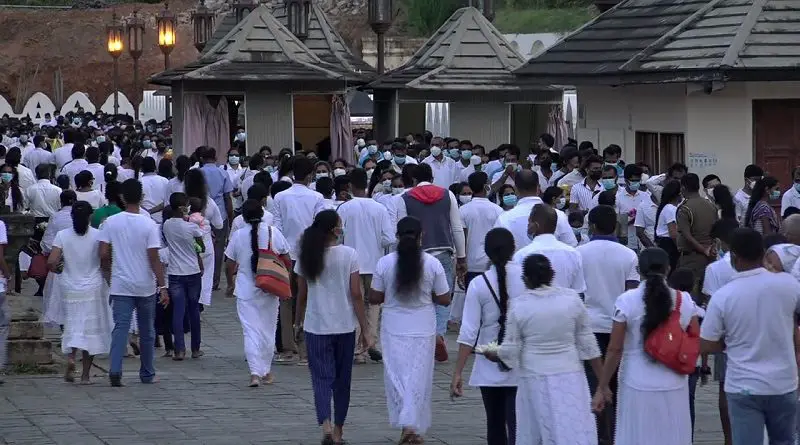
In Sri Lanka, Poya Days are of great importance and occur each month on the day of the full moon. These days are public holidays and hold significant religious value, especially for the Buddhist community.
- Impact on Travel: During Poya Days, public transport and other services might be busier than usual, as many locals travel to their hometowns or pilgrimage sites.
- Alcohol Sale Restrictions: It’s also notable that the sale of alcohol is prohibited on Poya Days, and many bars and restaurants might be closed.
Understanding the significance of Poya Days is crucial for travelers to plan their itineraries accordingly, ensuring a smooth and respectful travel experience in Sri Lanka.
FAQs
When planning a trip to Sri Lanka, several common questions arise regarding the best time to visit Sri Lanka. Here are some of the frequently asked questions to help you plan your journey:
Which is the best month to visit Sri Lanka?
The best month to visit Sri Lanka largely depends on what you want to do and see. For beach holidays and southern wildlife experiences, December to March is ideal which is one of the best time to visit Sri Lanka. For cultural festivals and exploring the Hill Country, September to October and April are excellent choices.
What month has the best weather in Sri Lanka?
Generally, the months with the best weather in Sri Lanka are December to March for the south and west coasts, and May to September for the north and east coasts. These periods typically have less rainfall and more sunny days.
What is the rainy season in Sri Lanka?
Sri Lanka experiences two main monsoon seasons. The Yala monsoon affects the south and west from May to August, while the Maha monsoon impacts the north and east from October to January.
What are the best dates to travel to Sri Lanka?
The best dates for travel depend on your interests. For beach and wildlife activities, aim for December to March which is one of the best time to visit Sri Lanka. For cultural experiences and fewer crowds, consider traveling during the shoulder seasons of September to October or April. However, it’s also importan




